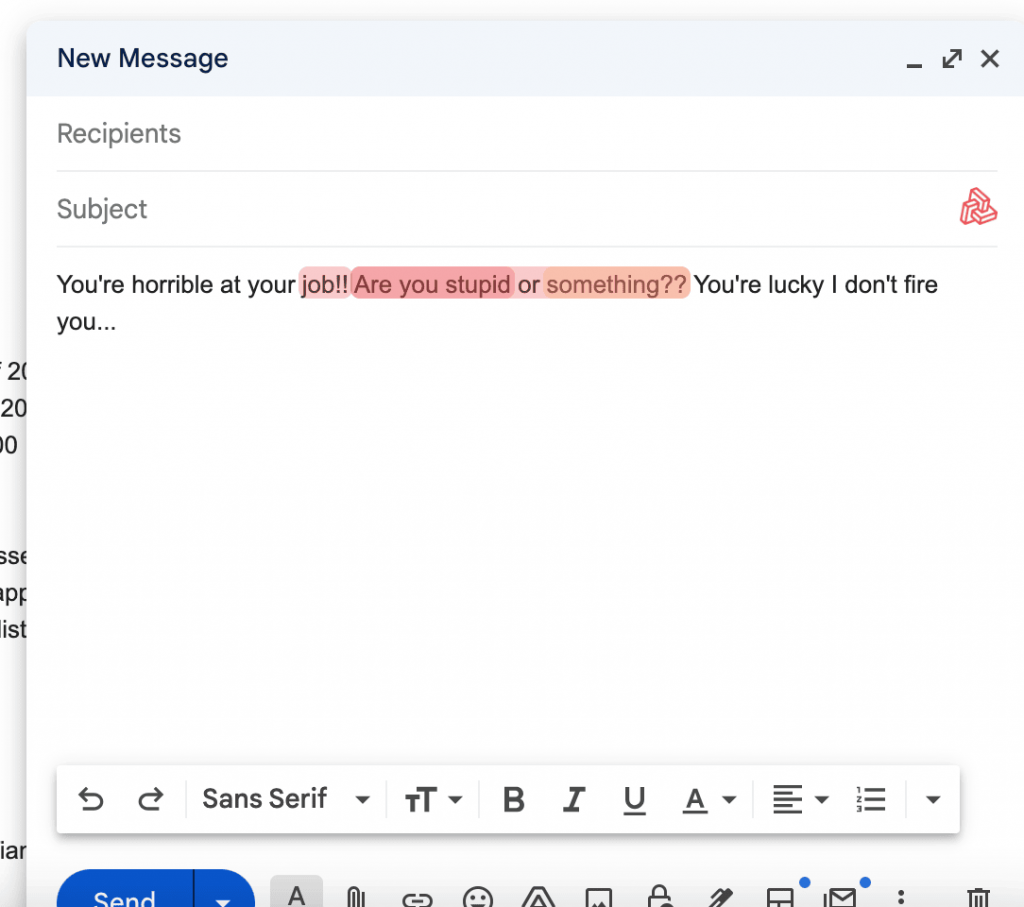Email Harassment: What is it and What’s the Law?
10 May 2023 | 7 mins read
- Employee resources
In our increasingly digital world, harassment has evolved from the traditional face-to-face interaction to an anonymous, online format, creating a new form of abuse – email harassment.

This form of harassment often leverages the anonymity of the internet, allowing the harasser to hide behind an email account.
Unlike an awkward conversation or an unpleasant encounter with a family member or a coworker, email harassment can be much more intrusive and pervasive. A text message or an email can reach us anywhere, at any time, making it feel like there’s no escape.
In the United States, federal law and state laws have been put in place to tackle this problem. However, the legal definition of harassment can vary from state to state. Therefore, it’s crucial to understand what constitutes harassment in your specific locality.
Furthermore, it’s important to remember that online harassment can extend beyond just email. Other channels where this type of harassment can occur include:
- Social media platforms
- Instant messages
- Message boards
- Text messaging channels
This harassment can range from unwanted advances, sexual harassment, and sexual assault to more subtle forms like making derogatory comments about a person’s sexual orientation, national origin, or gender identity, which can create a hostile work environment.
Unconsented contact through these electronic means, particularly if it involves sharing sensitive information or personal information without permission, is a serious concern. It’s not just a form of harassment—it’s a criminal offense in some jurisdictions, referred to as electronic harassment or cyber harassment. It’s crucial to recognize the signs and know when to seek legal advice or involve a law enforcement agency.
The impact of email harassment extends to every corner of our lives. It can lead to substantial emotional distress, affecting our mental health and overall well-being. It can also cause significant disruptions in the workplace, contributing to a drop in productivity and a hostile work environment.
In the following sections, we will delve deeper into the following topics:
- What is email harassment?
- The mental and physical impacts of harassment
- Why is inclusive language important?
- Email harassment laws and regulations
- What to do if you’re being harassed by email
We will also discuss how to use our app, Konsistent, to detect and prevent such behavior. Together, we can foster a safer, more respectful online communication environment.
Stay with us as we navigate this sensitive yet crucial topic, ensuring you’re armed with the knowledge to protect yourself and others from this insidious form of harassment.
Learn the best methods for protecting yourself against online bullying in our 20-page eBook. We'll give you a list of prevention tips, how to secure your communication online to prevent becoming a victim of online harassment, and give our best solutions and resources if you are a victim of online bullying.
What is email harassment?
Email harassment, in its simplest form, is the use of email to engage in a pattern of conduct causing distress or fear in a reasonable person. An online harasser may send threatening or obscene material, continually pester the recipient with unwanted emails, or even share the recipient’s personal information without consent.
The issue becomes even more complex when considering the various forms this harassment can take. It may involve a direct email attack or involve the use of third-party websites to spread false or damaging information about a specific person.
It’s crucial to remember that harassment isn’t restricted to strangers. A family member, a co-worker, or even an acquaintance can be an online abuser. It’s the willful course of conduct, not the identity of the harasser, that constitutes harassment under the law.
Certain forms of email harassment can also be classified as sexual harassment, particularly if the emails contain explicit or inappropriate content. An important point to note is that sexual harassment doesn’t discriminate based on sexual orientation or gender identity.
For a deeper understanding of the various forms of harassment, check out our article on What is considered harassment?.
The Impact of Email Harassment
Email harassment can have far-reaching effects – it can lead to substantial emotional distress, negatively impacting mental health. This is particularly true for victims who may feel violated or unsafe in their own homes due to the invasion of their private online spaces.
In the workplace, such harassment can create a hostile work environment, leading to decreased productivity and job satisfaction.

Our article on things that kill workplace productivity provides further insight into this issue.
In more severe cases, email harassment can escalate to threats of physical harm, sexual violence, or even domestic violence. If you are in immediate danger, it’s crucial to reach out to a police officer or another trusted authority figure for help.
It’s also important to understand that the societal cost of email harassment goes beyond the individual victims. It contributes to an overall climate of fear and intolerance that impacts us all. Our article on The effects of cyberbullying delves deeper into these societal impacts.
Remember, it’s okay to seek help if you’re a victim of harassment. There are many online resources available, including law students and experienced attorneys who can provide legal advice or even represent you in a criminal case if necessary.
In the next section, we will discuss the power of inclusive language in combating email harassment.
The Power of Inclusive Language
Language plays a significant role in our interactions, particularly in online communication where tone and body language are absent. The words we choose can either foster a sense of inclusivity and respect or lead to feelings of exclusion and distress.
Inclusive language, therefore, is not just a tool for politeness – it’s a crucial part of preventing email harassment.
Inclusive language acknowledges diversity and respects all aspects of people’s identities. This encompasses factors such as:
- Age
- Sex
- Gender identity
- Sexual orientation
- National origin
- and more
By using inclusive language, we can promote a culture of respect and prevent potential misunderstandings that might lead to feelings of harassment.
For example, using a person’s preferred pronouns in an email or avoiding racially or culturally insensitive phrases can go a long way in promoting a sense of respect and mutual understanding. For more tips on effective communication, check out our article on Effective Workplace Communication in the Digital Age.
It’s not just about avoiding harm, though. Inclusive language also brings benefits such as improved relationships and a more positive atmosphere. It creates a space where everyone feels valued and understood, which can dramatically improve productivity and satisfaction in the workplace.
This is particularly important when considering the link between harassment and decreased productivity, as discussed in our article on Things That Kill Workplace Productivity.
Remember, changing the way we communicate can be a powerful tool in reducing email harassment and creating a more respectful online environment. In the following section, we will delve into the legal framework surrounding email harassment.
Understanding Email Harassment Laws
Email harassment is a serious issue, and it’s important to understand that it’s not just an ethical issue but a legal one as well.
Depending on the nature and severity of the harassment, it can be considered a criminal offense under both federal law and state laws in the United States.
Is email harassment a crime?
Yes, email harassment is a type of cybercrime and it is considered a form of cyberstalking.
There are a few different laws in place to prevent this type of online behavior, and the consequences vary in severity depending on region.
What laws exist to fight email harassment?
At the federal level, there’s Title VII of the Civil Rights Act, which prohibits harassment based on race, color, religion, sex, and national origin in the workplace. It covers not only physical harassment but also harassment through electronic means such as email.
At the state level, the laws vary, but most states have laws in place to address electronic harassment. For example, under California law, specifically the California Penal Code, certain types of electronic communication, including email, can be considered criminal harassment if it involves credible threats or is intended to harass or annoy the recipient.
Harassment can lead to criminal charges, and in some cases, even result in jail time. For instance, a violator in Bristol County or Essex County could face time in county jail if found guilty of electronic harassment.
The legal definition of harassment can vary from one locality to another, so it’s important to understand the laws in your specific area. If you feel you’ve been a victim of email harassment, it may be helpful to consult with a cyber harassment lawyer to understand your options.
Our article on When to call a workplace harassment lawyer provides further insight into this issue.
It’s also worth noting that the law also offers protections for victims. A harassment prevention order, also known as a restraining order, can be issued by a court to protect victims from further harassment. Similarly, an abuse prevention order can be issued in cases of domestic violence.
Remember, the goal of these laws is to protect individuals from substantial emotional distress caused by harassment. If you’re facing such distress, don’t hesitate to seek legal advice and take appropriate action.
In the following section, we’ll discuss practical steps you can take to combat email harassment.
Practical Steps to Combat Email Harassment
Facing email harassment can be a distressing experience, but there are several steps you can take to protect yourself and seek justice.
- Documentation: It’s important to keep a record of all harassing emails. This includes not just the content, but also information like the sender’s email address and the date and time of the message. These can serve as evidence if you decide to file a criminal complaint.
- Report the harassment: Most email providers have a system in place to report harassment or abuse. If you’re receiving harassing emails, report them to your email provider. Social networking websites and internet service providers also have mechanisms in place for reporting abuse.
- Use technology to your advantage: Tools like our Konsistent Workplace Harassment Prevention Tool can help identify and prevent harassment in digital communication.
- Legal Action: If the harassment continues, it might be time to involve law enforcement or seek legal advice. Depending on your locality, you may be able to file a restraining order or a harassment prevention order against the harasser.
- Self-Protection: Be cautious about who has access to your personal information, including your email addresses and phone number. Make use of privacy settings on social networks and other online platforms to limit who can contact you.
- Support: Reach out to supportive friends, family, or professional counselors to help you deal with the emotional distress caused by the harassment. Remember, you’re not alone, and there are resources available to help.
Check out our article on How to prove harassment at work for more tips.
Final thoughts
Email harassment is a serious issue that can have severe impacts on a person’s mental health and overall well-being. While legal frameworks exist to protect individuals, awareness and education are our best defenses.
By understanding what constitutes email harassment and the steps we can take to combat it, we can create safer, more respectful online spaces.
At Konsistent, our mission is to inspire and encourage users to educate themselves on how to foster a more inclusive and respectful environment. Our AI language detection app is one step towards achieving that goal. Let’s work together to make our digital world a better place.







